

Des scientifiques français découvrent deux nouveaux types de virus géants. Ces virus sont si gros qu'ils pourraient bien être nos lointains ancêtres : des chercheurs français ont découvert deux nouveaux virus si grands qu'ils pourraient constituer à eux seuls une nouvelle forme de vie, selon une étude publiée jeudi.
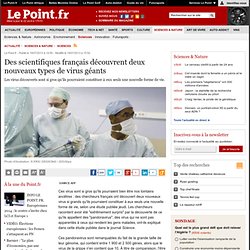
Les chercheurs racontent avoir été "extrêmement surpris" par la découverte de ce qu'ils appellent des "pandoravirus", des virus qui ne sont pas apparentés à ceux qui rendent les gens malades, ont-ils expliqué dans cette étude publiée dans le journal Science. Ces pandoravirus sont remarquables du fait de la grande taille de leur génome, qui contient entre 1 900 et 2 500 gènes, alors que le virus de la grippe n'en contient que 10.
Le plus ancien génome jamais analysé. Une équipe internationale de chercheurs dirigée par le Français Ludovic Orlando a réussi à reconstituer l'ADN d'un animal préhistorique vieux de 735 000 ans.

Le tout grâce à un morceau d'os de patte découvert en 2003, dans le pergélisol (sol perpétuellement gelé) du Yukon, au Canada. Un fragment qui mesurait tout au plus 15 centimètres sur 8. First love child of human, Neanderthal believed found. Getty Images Neanderthals like the one depicted in this museum reconstruction died out tens of thousands of years ago.
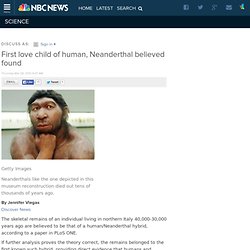
By Jennifer ViegasDiscover News The skeletal remains of an individual living in northern Italy 40,000-30,000 years ago are believed to be that of a human/Neanderthal hybrid, according to a paper in PLoS ONE. If further analysis proves the theory correct, the remains belonged to the first known such hybrid, providing direct evidence that humans and Neanderthals interbred. Prior genetic research determined the DNA of people with European and Asian ancestry is 1 to 4 percent Neanderthal. The present study focuses on the individual’s jaw, which was unearthed at a rock-shelter called Riparo di Mezzena in the Monti Lessini region of Italy.
Neanderthals' large eyes led to their downfall, says study - Science - News. This meant that a larger section of their brains was devoted to maintaining good vision during the long, dark nights of the period, leaving less room for higher-level thinking processes and eventually leading to their extinction, scientists claim. Although their brains were similar in size to those of modern-day man, new analysis of fossil data by the University of Oxford and the Natural History Museum in London shows that their brain structure was markedly different. Significantly less space was devoted to the cognitive functions that allowed Homo Sapiens to survive the ice age by creating warmer clothes and developing larger social groups. Épigénétique. Une solidarité sans limite entre extrêmophiles. Répartition géographique et origines ethniques des haplogroupes européens. Dernière mise à jour de la version française en septembre 2013 (A, C, G2a, I2, J2, L, Q, R1a, R1b, T + toutes les cartes) pour la section ADN-Y et février 2010 pour la section ADNmt.Ce site utilise la désignation neutre d'Ère commune (EC ou AEC) pour les dates.

Des études sur l'ADN ont permis de catégoriser tous les êtres humains sur Terre en une série de groupes généalogiques descendants d'un ancêtre commun à un moment de la préhistoire. On appele ces catégories des haplogroupes. Il y a deux sortes d'haplogroupes : les haplogroupes définissant le chromosome Y (Y-ADN) hérité de père en fils, et ceux de l'ADN mitochondrial (ADN mt), toujours hérité par la mère. Le premier renseigne donc sur les ancêtres de la lignée agnatique (ou patrilinéaire), et la seconde sur la lignée cognatique (or matrilinéaire). COURS DE GÉNÉTIQUE DES POPULATIONS. Un gène de l’éternelle jeunesse découvert chez un invertébré aquatique. L’homme qui ne descendait pas d’Adam. Evolution and the ice age. Dr John Stewart has made important contributions to a growing body of work that shows how the evolution of ecosystems has to be taken into account when speculating between different geological eras.
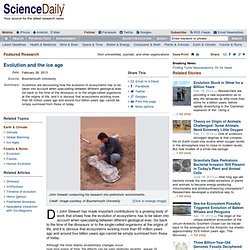
Go back to the time of the dinosaurs or to the single-celled organisms at the origins of life, and it is obvious that ecosystems existing more than 65 million years ago and around four billion years ago cannot be simply surmised from those of today. Although the most drastic evolutionary changes occur over long spans of time, the effects can be seen relatively recently, argues Dr Stewart. Stewart has studied the interaction between ancient ecosystems -- paleoecology -- and evolution of humans and other organisms over the past 100,000 years, undertaking everything from excavating cave sites in Belgium to exploring the desert of Abu Dhabi. What Happened When Humans Met An 'Alien' Intelligence? Sex Happened : Krulwich Wonders...
We have dreamed about it for so long.
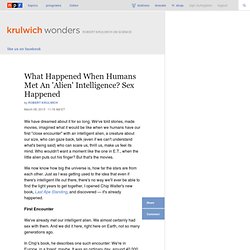
We've told stories, made movies, imagined what it would be like when we humans have our first "close encounter" with an intelligent alien, a creature about our size, who can gaze back, talk (even if we can't understand what's being said) who can scare us, thrill us, make us feel its mind. Who wouldn't want a moment like the one in E.T., when the little alien puts out his finger? But that's the movies. We now know how big the universe is, how far the stars are from each other. Interbreeding With Neanderthals. Despite the challenge, Reich thought that detecting interbreeding could be important.

It could expose some of humanity’s hidden history, or even shed light on why people are susceptible to certain diseases. When Reich arrived at Harvard Medical School, he began a study on prostate cancer that proved the value of this type of analysis by revealing the genes that make certain men more likely to develop such cancers. “Prostate cancer occurs 1.5 to 2 times more often in African American men than in European men,” Reich says.
“We were able to find the reason why.” To do so, Reich had to reconstruct the genetic history of African Americans, who came to the United States as slaves beginning in the 17th century. Was it possible that Europeans and Asians had a little Neanderthal DNA after all? Reich and his colleagues inspected the DNA of 1,597 African American men with prostate cancer. Interbreeding in the United States took place over just the past few centuries. The Neanderthals May Have Died Out Because of ... Bunnies? - Megan Garber. According to a new paleontological analysis, our furry friends allowed us to thrive -- while Neanderthals died away.
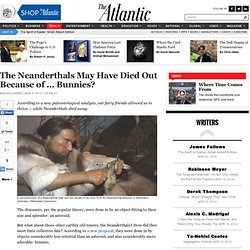
A reconstruction of a Neanderthal male and the results of his hunt, from the Neanderthal Museum in Mettmann, Germany (Wikimedia Commons) The dinosaurs, per the popular theory, were done in by an object fitting to their size and splendor: an asteroid. But what about those other earthly old-timers, the Neanderthals? How did they meet their collective fate? According to a new proposal, they were done in by objects considerably less celestial than an asteroid, and also considerably more adorable: bunnies. 'Adventurous human woman' wanted to give birth to Neanderthal man by Harvard professor. Professor George Church of Harvard Medical School believes he can reconstruct Neanderthal DNAHis ambitious plan requires a human volunteer willing to allow the DNA to be put into stem cells, then a human embryo By Allan Hall and Fiona Macrae Published: 15:36 GMT, 20 January 2013 | Updated: 09:16 GMT, 21 January 2013 Neanderthals have been extinct for 33,000 years, but George Church, a genetics professor at Harvard Medical School, believes he can bring them back with the help of a surrogate human mother.

Cloner l'homme de Néandertal: la folle idée de George Church. CLONAGE - Il a la barbe bien fournie, l'air débonnaire et le sourire franc.

En apparence, George Church n'a donc rien du savant fou. Palaeolithic Park? Harvard professor seeks 'adventurous' woman to give birth to baby Neanderthal - Science - News. It may sound like the plot of another Jurassic Park sequel, but the request is actually part of Professor George Church’s real-life plan to bring our long-extinct relative back to life. Professor Church of Harvard Medical School is one of the world’s leading geneticists and believes his Neanderthal bone-sample analysis is now complete enough to reconstruct their DNA. Although the 58-year-old is not certain his plan would work, he says he is now ready to put theory into practice. Speaking to the German magazine Der Spiegel, Professor Church said: “Now I need an adventurous female human…It depends on a hell of a lot of things, but I think it can be done.” Professor Church’s plan is to create artificial Neanderthal DNA based on the genetic code found in bone samples, then put this DNA into stem cells.
These cells would then be injected into a human embryo in the early stages of life, and would be strong enough to steer the embryo’s development along Neanderthal lines rather than Sapien.